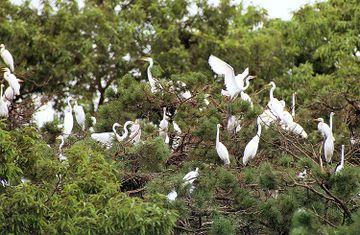"여주 신접리 백로와 왜가리 번식지"의 두 판 사이의 차이
(새 문서: {{진행중}} {{문화유산정보 |사진=여주신접리백로와왜가리번식지.jpg |사진출처=[http://www.heritage.go.kr/heri/cul/culSelectDetail.do?ccbaCpno=1363102090000...) |
(→영문) |
||
| 39번째 줄: | 39번째 줄: | ||
===영문=== | ===영문=== | ||
| + | '''Breeding Ground of Egrets and Grey Herons in Sinjeop-ri, Yeoju''' | ||
| + | |||
| + | Egrets and grey herons are long-legged freshwater and coastal birds in the family Ardeidae. These birds are widespread in tropical and temperate regions, and they feed on herpitile/amphibians and reptiles. | ||
| + | |||
| + | Since the 1960s, egrets and grey herons in Sinjeop-ri, Yeoju, bred mainly among the branches of an over 400-year old ginkgo tree. However, the tree died due to the damage caused by bird droppings, and nowadays the birds breed in pine, oak and chestnut trees. The breeding ground is located close to Geumdangcheon Stream and (wet) farmlands/rice paddies, an area suitable for feeding. | ||
| + | |||
| + | The birds arrive at the breeding grounds and start laying eggs in the middle of February. They stay with their young until the end of July, after which they scatter around the nearby area. In 1970, the local population of egrets and grey herons was estimated to have had as many as 1000 species, though recently the number decreased greatly. | ||
===영문 해설 내용=== | ===영문 해설 내용=== | ||
2019년 12월 16일 (월) 09:43 판
| 여주 신접리 백로와 왜가리 번식지 Breeding Ground of Egrets and Grey Herons in Sinjeop-ri, Yeoju |
|
 여주 신접리 백로와 왜가리 번식지, 국가문화유산포털, 문화재청. |
|
| 대표명칭 | 여주 신접리 백로와 왜가리 번식지 |
|---|---|
| 영문명칭 | Breeding Ground of Egrets and Grey Herons in Sinjeop-ri, Yeoju |
| 한자 | 驪州 新接里 白鷺와 왜가리 繁殖地 |
| 주소 | 경기도 여주시 북내면 신접리 285 |
| 지정번호 | 천연기념물 제209호 |
| 지정일 | 1968년 7월 24일 |
| 분류 | 자연유산/천연기념물/문화역사기념물/민속 |
| 웹사이트 | 여주 신접리 백로와 왜가리 번식지, 국가문화유산포털, 문화재청. |
|
|
|
해설문
국문
백로와 왜가리는 전 세계 열대 지방과 온대 지방에 널리 분포하며, 우리나라에서는 백두산 지역을 제외한 전 지역에서 번식한다.
여주에서는 1960년대부터 북내면 신접리의 400년 된 은행나무에서 집중적으로 번식했는데, 이 나무가 말라 죽은 이후 현재는 리기다소나무, 아까시나무, 밤나무, 상수리나무, 소나무, 졸참나무 등에서 번식하고 있다. 이곳에 도래하는 백로류는 왜가리, 중대백로, 중백로, 쇠백로, 황로 등 총 5종이다.
2월 중순 왜가리 도래를 시작으로 중대백로, 쇠백로, 황로, 중백로 순으로 도래한다. 짝짓기 시기는 대부분 2월 하순부터 5월 초순이며, 포란은 3월 중순부터 5월 하순, 육추는 7월 하순까지이다. 번식이 종료되면 인근 지역으로 분산되어 번식지에는 소수만 남는다.
백로와 왜가리는 번식지 주변의 금당천과 농경지에서 주로 먹이 활동을 하며, 작은 물고기와 양서 파충류를 잡아먹는다.
여주 신접리의 번식지는 우리나라 중부 지역에 위치한 백로와 왜가리의 번식지를 대표하기 때문에 천연기념물로 지정·보호하고 있다.
- 포란 : 알 품기
- 육추 : 새끼 키우기
영문
Breeding Ground of Egrets and Grey Herons in Sinjeop-ri, Yeoju
Egrets and grey herons are long-legged freshwater and coastal birds in the family Ardeidae. These birds are widespread in tropical and temperate regions, and they feed on herpitile/amphibians and reptiles.
Since the 1960s, egrets and grey herons in Sinjeop-ri, Yeoju, bred mainly among the branches of an over 400-year old ginkgo tree. However, the tree died due to the damage caused by bird droppings, and nowadays the birds breed in pine, oak and chestnut trees. The breeding ground is located close to Geumdangcheon Stream and (wet) farmlands/rice paddies, an area suitable for feeding.
The birds arrive at the breeding grounds and start laying eggs in the middle of February. They stay with their young until the end of July, after which they scatter around the nearby area. In 1970, the local population of egrets and grey herons was estimated to have had as many as 1000 species, though recently the number decreased greatly.
영문 해설 내용
백로와 왜가리는 왜가리과에 속하는 큰 새이다. 전세계 열대 지방과 온대 지방에 널리 분포하며, 물고기와 양서 파충류를 잡아먹는다.
여주 신접리에서는 1960년대부터 이 마을의 400년 이상된 은행나무에서 백로와 왜가리가 집중적으로 번식하기 시작하였다. 그러나 이 은행나무는 새의 배설물로 인해 죽었으며, 지금은 이후 심은 소나무, 밤나무, 상수리나무 등에서 번식하고 있다. 번식지 주변에는 금당천과 농경지가 있어서 먹이 활동을 하기에 적합하다.
2월 중순에 도래하기 시작해 알을 낳고 새끼를 키우는 7월 하순까지 이곳에 머물고, 이후에는 인근 지역으로 분산된다. 1970년대에는 개체 수가 1,000여 마리에 달했으나, 최근에는 개체 수가 크게 감소하였다.